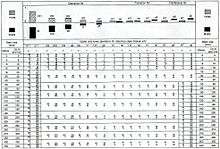IT Grade
IT Grade refers to the International Tolerance Grade of an industrial process defined in ISO 286.[1] This grade identifies what tolerances a given process can produce for a given dimension.
The specific tolerance for a particular IT grade is calculated via the following formula:[2]
where:
- T is the tolerance in micrometres [μm]
- D is the geometric mean dimension in millimeters [mm]
- ITG is the IT Grade, a positive integer.
One thinks of as being the key dimension on the part and as being the required tolerance on that key dimension. The larger the ITG, the looser the tolerance.

Meaning and interpretation
An industrial process has an IT Grade associated with it, indicating how precise it is. When designing a part, an engineer will typically determine a key dimension (D) and some tolerance (T) on that dimension. Using this formula, the engineer can determine what IT Grade is necessary to produce the part with those specifications. Thus, if injection molding has an IT Grade of 13 and a part needs an IT Grade of 5, one cannot injection mold that part to those specifications. It is useful in determining the processes capable of producing parts to the needed specification.[2]
Alternate formulation
In "Manufacturing Processes II" (Tata McGraw-Hill Education) by H S Bawa, the following equation is given on page 95 for sizes over 500 mm:
| ITG | IT5 | IT6 | ... | IT17 | IT18 |
|---|---|---|---|---|---|
| k | 7 | 10 | ... | 1600 | 2500 |
References
- "ISO 286-1:2010(en) Geometrical product specifications (GPS) — ISO code system for tolerances on linear sizes — Part 1: Basis of tolerances, deviations and fits". ISO.
- "International Tolerance (IT) Grades Table Chart". www.engineersedge.com. Retrieved 22 February 2017.
External links
- ISO Hole and Shaft tolerances/limits, Roymech, UK.
- ISO Hole and Shaft Tolerances iPhone App, Trelleborg Sealing Solutions Germany.